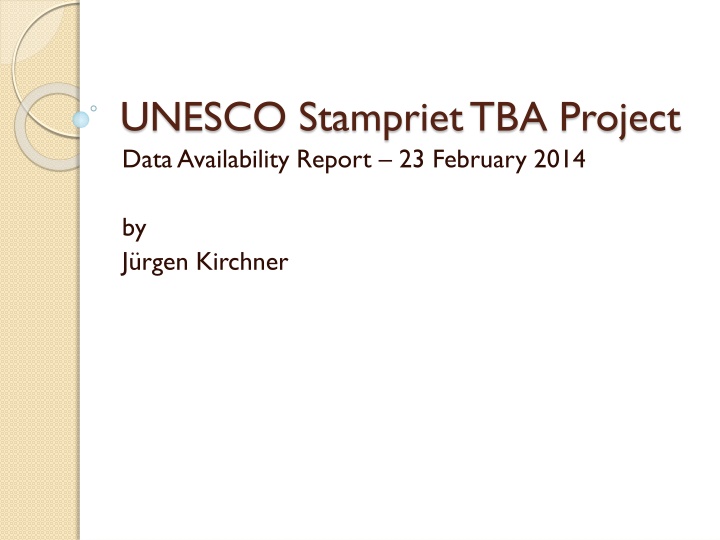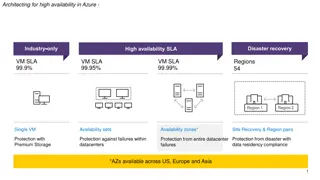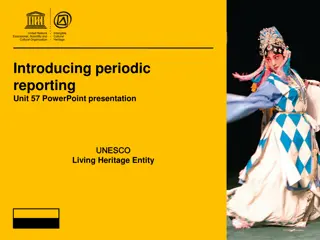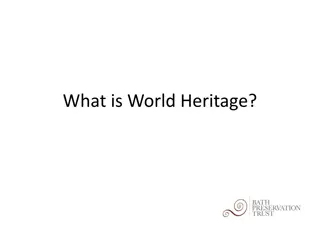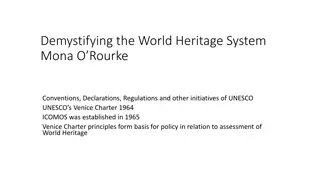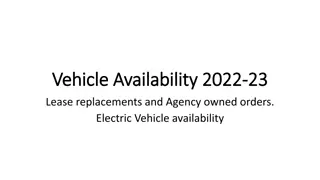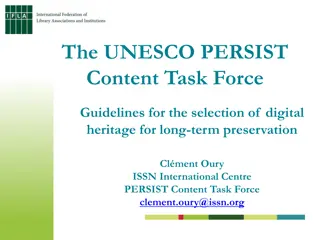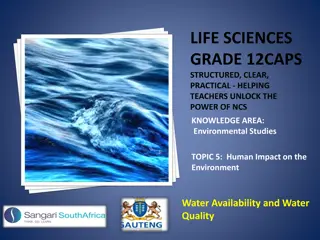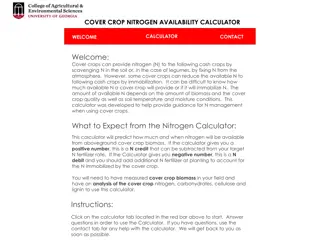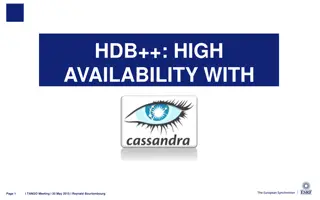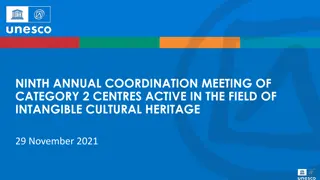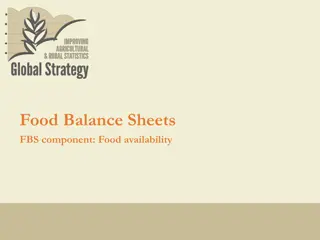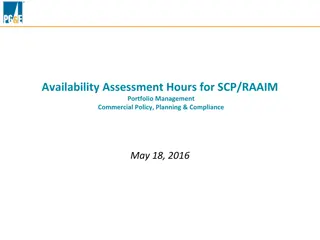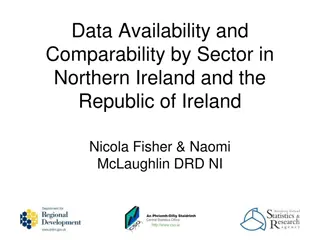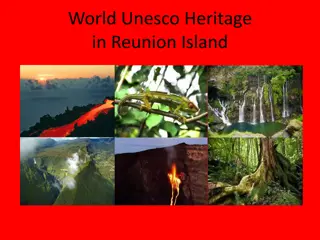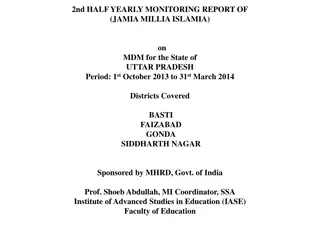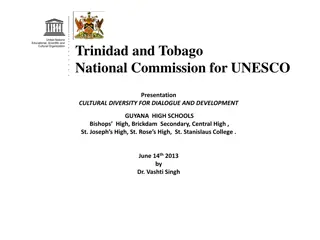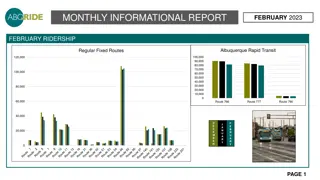UNESCO Stampriet TBA Project Data Availability Report February 2014
This report by Jürgen Kirchner provides information on the availability of data related to the UNESCO Stampriet TBA project, ranging from physiography and climate to hydrogeological characteristics and socio-economic aspects. It discusses temperature, precipitation, evapotranspiration, land use/land cover, and topography/elevation data from Botswana, Namibia, and South Africa.
Download Presentation

Please find below an Image/Link to download the presentation.
The content on the website is provided AS IS for your information and personal use only. It may not be sold, licensed, or shared on other websites without obtaining consent from the author.If you encounter any issues during the download, it is possible that the publisher has removed the file from their server.
You are allowed to download the files provided on this website for personal or commercial use, subject to the condition that they are used lawfully. All files are the property of their respective owners.
The content on the website is provided AS IS for your information and personal use only. It may not be sold, licensed, or shared on other websites without obtaining consent from the author.
E N D
Presentation Transcript
UNESCO Stampriet TBA Project Data Availability Report 23 February 2014 by J rgen Kirchner
Items will be discussed in the usual order A. Physiography and Climate B. Aquifer geometry C. Hydrogeological characteristics D. Environmental aspects and E. Socio-economic aspects
Physiography and Climate A.1. Temperature Botswana: 1959-2012 Tshane & Tshabong [ C] Namibia: 6 Stations, varying periods between 1977 and 2014 from NOAA [ F] South Africa: Data available at SA Weather Service and Agricultural Research Council against cost. Data appear to be available. It is suggested that long term mean minimum and maximum values from stations in and around the project area are combined in an xls or dbf file and then plotted on the TBA base map still to be prepared.
Physiography and Climate A.2. Precipitation Botswana: Data are available for 7 stations between 1970 (1979) to 2012 [mm] Namibia: 6 Stations, varying periods between 1977 and 2014 from NOAA [inches] South Africa: Data available at SA Weather Service and Agricultural Research Council against cost. Annual rainfall data for a number of stations are available. mean annual precipitation data can be plotted on the TBA delineated map still to be prepared.
Physiography and Climate A.3. Evapotranspiration Botswana: Data for Tshane 1959-2009 and Tshabong 1959-2007 are available. Namibia: Namibia has only a map that shows the mean annual evaporation. South Africa: A spreadsheet with evaporation data from1961 to 1983 is available. Compilation of a map showing the mean annual evaporation in steps of 200 mm is proposed.
Physiography and Climate A.4. Land use/Land cover Botswana: The intention is to digitize Google Earth maps. Namibia: A map of irrigation sites is available. Reference is made to the JICA report. South Africa: No such data have been collected. Known land uses are Stock farming; Irrigation Nature conservation/Game parks/Tourism with possibly some Lodges which can be taken from maps. Lodge coordinates must be identified
Physiography and Climate A.5. Topography and Elevation Botswana: Shape files and maps are available Namibia: Maps and a digital elevation model is available South Africa: Data are available as shape files. A digital elevation model for the whole TBA area can be produced from SRTM or ASTER data. Contour lines can also be created from these data.
Physiography and Climate A.6. Surface Water Networks Botswana: Rivers and pans are available as shape files Namibia: Rivers and pans are available as shape files South Africa: Rivers are available as shape files. Pans are assumed to be available. A map of the surface water features (ephemeral rivers and pans) can be produced from the collected data and plotted on the TBA base map still to be prepared.
Physiography and Climate SUMMARISING Although the respective xls files have still to be created no problems are foreseen to prepare tables and maps for Temperature Rainfall Evaporation Topography and Elevation and Surface water networks can be produced Data for the Land use map must be generated
Aquifer Geometry B.1. Hydrogeological map Botswana: 1:1 000 000 map is available Namibia: 1:1 000 000 map is available [tif & jpg] South Africa: 1:500 000 map is available A map showing lithology and groundwater potential can be produced from the available data. While the Namibian map represents largely the properties of TBA aquifers (rock types and potential) the Botswana and South African maps depict largely the properties of the Kalahari aquifers. I assume that the Botswana Hydrogeological map reflects the Kalahari aquifer in the area of the TBA aquifer.
Aquifer Geometry B.2. Geo-referenced boundary of the TBA aquifer Botswana: Two delineation versions have been offered Namibia: Based on Google Earth & Miller 2008 South Africa: Include outliers? A decision must still be taken about the eastern boundary of the Botswana TBA area and the South African TBA boundary must be changed so that it meets the Namibian one about 20 km south of Mata Mata.
Aquifer Geometry B.3. Depth of water table/piezometric water level Botswana: There are maps in reports and hopefully DWA and GSD database data Namibia: Monitoring data are insufficient. 400 JICA data exist South Africa: Good Kalahari data exist no TBA One map each for Kalahari and TBA is needed. For parts of Botswana and for Namibia data are available. For South Africa probably only Kalahari data.
Aquifer Geometry B.4. Depth to top of aquifer formation Botswana: Report, BCR and probably database data are available Namibia: Miller, 2008 contains maps and sections South Africa: Good Kalahari data exist some cross- sections showing Karoo were also provided by the specialist. Cross-sections can be constructed. It will be difficult to compile a map as sufficiently deep boreholes with coordinates exist only in parts of Botswana and South Africa.
Aquifer Geometry B.5. Vertical thickness of aquifer Botswana: Information is available e.g. from the Matsheng report Namibia: Miller 2008 contains maps and cross-sections South Africa: Good information on the Kalahari exists, for TBA aquifers there are much less data. From the above information cross-sections through the basin can be constructed. It appears unlikely that a map can be drawn showing the thickness of the TBA aquifer as boreholes (with coordinates) that have penetrated the Ecca aquifers are largely missing in parts of the Botswana and South African TBA catchment.
Aquifer Geometry B.6. Degree of confinement Botswana: G. Lentswe reckons he can extract the data from BCRs and the Matsheng report Namibia: Kalahari is unconfined, Auob and Nossob are confined to semi-confined in the Salt Block South Africa: Kalahari is unconfined, TBA is semi-confined Degree of confinement is a qualitative statement which can be described rather than plotted on maps. The available information suffices.
Aquifer Geometry B.7. Representative cross-sections The data needed for and the construction of cross- sections have already been discussed above under B.4. Depth to top of aquifer formation and B.5. Vertical thickness of the aquifer.
Aquifer Geometry SUMMARISING A decision on the TBA delineation must be taken. Hydrogeological maps are available but need to be harmonised. Botswana has only boreholes in part of the catchment and in South Africa TBA information is scarce.
Hydrogeological Characteristics C.1. Aquifer Recharge Botswana: G. Lentswe reckons he can extract sufficient data from available reports. Namibia: Figures for various scenarios exist South Africa: Kalahari recharge values available A reasonable estimate of the mean recharge of the Kalahari aquifers can be made. There is no recharge in the TransNossob. Considerable uncertainty remains regarding the mean recharge as individual events produce results varying by a factor of 102.
Hydrogeological Characteristics C.2. Aquifer Lithology Botswana: G. Lentswe listed the publications from which he can get the lithology. Namibia: L. Joel extracted from JICA & Miller 2008 South Africa: L. Leshomo extracted from Haddon 2005 For Botswana the lithology of the different aquifers (Kalahari, Ntane and Otshe) still needs to be extracted from the literature. For the Namibian and South African aquifers it is available.
Hydrogeological Characteristics C.3. Soil types Botswana: A jpg image of soil and explanatory notes are available. Namibia: D. Muroua has compiled a soil map South Africa: A map showing Kalahari sand is attached to J. Leshomo s report. Maps from all three countries are available. The Botswana map needs to be digitised and all three maps must then be harmonised.
Hydrogeological Characteristics C.4. Porosity Botswana: G. Lentswe cites six publications that contain porosity information Namibia: No porosity values for the Kalahari exist. For the Auob values just over 20% were determined. South Africa: Currently there are no data on porosity. Namibia has some values - further values for TBA aquifers can be found in pumping test data. While Botswana has still to extract data from literature, South Africa reports that so far there are no porosity data are available.
Hydrogeological Characteristics C.5. Transmissivity and vertical permeability Botswana: G. Lentswe cites six publications that contain porosity information Namibia: No porosity values for the Kalahari exist. For the Auob values just over 20% were determined. South Africa: Currently there are no data on porosity. Namibia has some values - further values for TBA aquifers can be found in pumping test data. While Botswana has still to extract data from literature, South Africa reports that so far there are no porosity data are available.
Hydrogeological Characteristics C.6. Total Groundwater Volume Botswana: No data collected so far. In the Matsheng report there is a table with assumed reserves Namibia: There are insufficient data to describe this parameter for any of the 11 aquifers. Falke risked a trial. South Africa: van Wyk provided some estimates Lentswe has not yet tried to calculate any storage values. Some values are in the Matsheng report. In Namibia one attempt has been made and in South Africa E. van Wyk has assessed the water stored in the Kalahari. The TBA figures are not regarded reliable. The stored water is not extractable because the Auob aquifer is collapsible.
Hydrogeological Characteristics C.7. Groundwater depletion Botswana: No data source identified so far Namibia: Sufficient long term water level graphs are not available South Africa: It is assumed that the Kalahari aquifer is under-utilised Water-level monitoring records do not allow a definite statement whether the TBA aquifers are depleted. Preliminary indications are, however, that this is not the case.
Hydrogeological Characteristics C.8. Natural discharge mechanism Botswana: No data source identified so far Namibia: Evapotranspiration is the discharge mechanism in the Kalahari aquifer. At the lower end of the basin, groundwater flows out of the TBAs into the Kalahari South Africa: Evapo(trans)piration is the assumed discharge mechanism For all aquifers the predominant discharge mechanism is evapotranspiration - for the TBA aquifers it is through seepage into the Kalahari aquifer.
Hydrogeological Characteristcs SUMMARISING Some Botswana data still need to be extracted (Recharge, Lithology, Porosity, Transmissivity) and the TBA delineation must be decided on. For porosity and transmissivity there are not sufficient data to construct a map. Neither for the Kalahari nor for the TBA can a reliable value be given for the stored reserves. TBA stored resources can in any case not be abstracted.
Environmental Aspects D.1. Natural Groundwater quality Botswana: In general the groundwater quality is low Namibia: The water quality ranges from good to unsuitable. NSI data are questionable. South Africa: There are no springs in this area. There is sufficient information to produce a groundwater quality map. For harmonisation the Standards (WHO or national) must be decided on. Main problems are TDS/EC, and Nitrate. In a few places Fluoride is even to high for animal consumption.
Environmental Aspects D.2. Pollution Botswana: Nitrate is the main pollutant Namibia: The water quality ranges from good to unsuitable. NSI data are questionable. South Africa: There are no springs in this area . Although of local importance at places such as e.g. Hoachanas or Aminuis the yield of springs is so low that they do not play any role in the water balance of the Stampriet Artesian Basin. No springs have been reported from the Botswana and South African part of the Stampriet TBA.
Environmental Aspects D.3. Solid Waste and Waste Water Control Botswana: The specialist could not yet collect information Namibia: Information from the towns and settlements is collected. South Africa: Only the number of households that are served is recorded. Field data for Botswana for Botswana have not been collected. Those for Namibia have been obtained for solid waste and were calculated for waste water. For South Africa these data were not recorded. It is suggested that the Botswana data are so that at least for these two countries harmonized reporting is possible.
Environmental Aspects D.4. Shallow water table Botswana: No such data were reported Namibia: There are only a few weak springs. South Africa: No such data were reported Apart from a few comparatively weak springs shallow water exists at places in the Auob and Nossob River which support invasive alien Prosopis vegetation thereby supplanting the native acacia trees.
Socio-economic Aspects E.1. Population (total density) Botswana: Kalagadi North and South figures are available Namibia: The TBA is covered by parts of eight constituencies. South Africa: Data for the Mier Municipality are available only Population figures are available in all three countries. The problem is that they have been collected for politically or administratively determined areas which do not coincide with the TBA delineation.
Socio-economic Aspects E.2. Groundwater use Botswana: Only groundwater is used but data are difficult to obtain Namibia: Water is used for human use; stock watering; and irrigation. Mostly indirect data will have to be used. South Africa: The DWA database is said to contain abstraction data. The available information on groundwater use is incomplete. Figures are available for public water supply. Figures for non public water supply, e.g. use on farms for human use and stock watering can only be calculated based on number of persons and carrying capacity of the land. Namibian. Irrigation use could be approximated.
Socio-economic Aspects E.4. Dependence of Industry and Agriculture on groundwater Botswana: Preliminary results show the construction industry (brick moulding and building construction) and livestock watering to be the largest consumers Namibia: There are no industries in the aquifer area and the agricultural sector depends solely on groundwater. South Africa: Human consumption, stock watering. tourism and wildlife depend on groundwater. It can be assumed that there is no surface water use of any practical importance.
Socio-economic Aspects E.6. Percentage of population covered by public sanitation Botswana: Type of toilet and number of household for each type are available. Namibia: Figures are available for whole constituencies South Africa: Percentage of households per toile type is available. As for E.5. The data are available for administrative or politically demarcated areas and not for the Stampriet TBA delineated area.
Socio-economic Aspects SUMMARISING The socio-economic data are generally available, however they refer to political or administratively demarcated areas, which makes it impossible to link these data to the Stampriet Transboundary Aquifer area.
